Understanding International Maritime Signal Flags
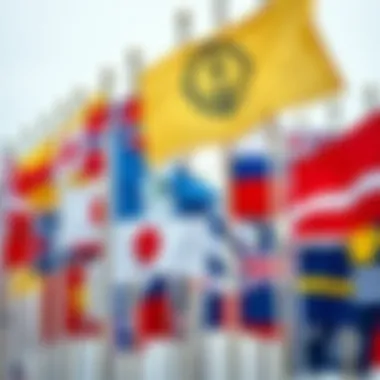

Intro
When one thinks of the vast oceans, an image of endless waves and a serene horizon often comes to mind. Yet beneath the tranquil facade lies a complex system of communication, crucial for the safety of those who navigate these waters. International maritime signal flags serve as the backbone of this communicative tapestry, allowing sailors to convey messages with clarity and precision. From simple navigational instructions to warnings of impending danger, these flags are more than mere fabric; they embody a rich history and a vibrant culture.
Throughout time, the evolution of maritime signals has mirrored advancements in navigation and safety practices. As ships began to sail further from coastlines, the need for effective communication mechanisms emerged. The use of flags allowed vessels to send visual messages over considerable distances, transcending language barriers and mitigating the risks associated with miscommunication.
Interestingly, the design of these flags is not arbitrary. Each flag represents a letter of the alphabet, with unique designs that denote specific meanings. For those who venture into the realm of surfing, understanding these flags takes its own shape. Surf culture has appropriated some elements of maritime communication, creating a dialogue between the water's inhabitants and those riding the waves. Whether you are a seasoned surfer or a curious traveler, grasping the fundamentals of maritime signal flags can enrich your experience on the water.
In this piece, we will embark on a thorough exploration of maritime signal flags. We’ll highlight their historical journey, decipher their color symbolism, and address how they empower safety and efficiency at sea. Furthermore, we’ll probe into the contemporary adaptations in surfing culture, demonstrating the ongoing relevance of these flags.
Prepare to dive deep into the waves, unravel the stories behind these vibrant pieces of cloth, and learn how they weave the fabric of maritime communication.
Understanding Maritime Communication
Maritime communication serves as the backbone of safe navigation and operational efficiency at sea. With vast expanses of ocean separating vessels from shore and each other, the ability to communicate clearly and instantly is paramount. This is where maritime signal flags come into play, providing a visual means of communication that transcends language barriers. Whether sailing a yacht or steering a massive cargo ship, all mariners must grasp the principles underlying maritime signaling to ensure effective interaction on the open waters.
One of the foremost benefits of comprehending maritime communication is safety. The sea is unpredictable; conditions can change swiftly, and alerts often arise unexpectedly. Here, flags act as crucial signals indicating emergencies or essential messages. Here are key points one should consider in maritime communication:
- Real-time Updates: Flag signals can convey crucial messages without delay, contrasting with radio communication which may suffer from interference.
- Universal Language: The design and colors of signal flags are internationally recognized, allowing for clear understanding between vessels from diverse backgrounds.
- Accessibility: Signal flags are visual, making them understandable even in adverse weather conditions or amidst the tumult of the sea, where sound signals might fail.
The key challenges in maritime communication involve not just the understanding of the flags themselves but also the proper procedures for their usage. In the hustle of modern navigation, many new mariners might overlook the significance of these flags, but their proper recognition and application could be the difference between safe passage and a navigational mishap.
"Communication at sea needs to be as clear as the waters underneath. When you send a signal, someone’s life might depend on it."
Given these considerations, fostering a profound understanding of maritime signaling can greatly enhance the seafaring experience for everyone involved—from seasoned sailors to new enthusiasts. It is not merely about tradition; it is a vital aspect of maritime safety and professionalism that still holds relevance today.
A Brief History of Maritime Signaling
The roots of maritime signaling can be traced back to ancient civilizations. In fact, many cultures used simple visual signs to communicate across water. Over centuries, these basic forms evolved into more sophisticated signaling methods, making maritime communication more standardized and effective.
The medieval period saw the use of flags becoming more commonplace among European navies. With the advent of naval warfare, each nation developed its own fleet colors and flag signaling systems. By establishing distinct flags, ships could communicate their intent, identity, or operational status at a distance, even before their components and strategies became more complex.
As trade expanded globally, the need for a universal system of flags became more pressing. It wasn’t until the 19th century that a comprehensive international code was formed, enhancing coherence in signaling practices across different countries. This step was monumental in creating a standardized approach that would ensure that seafarers from various maritime nations could communicate effectively.
Importance of Visual Communication
Visual communication, particularly through flags, is integral to effective maritime operations. Seafarers often operate under difficult conditions where traditional communication methods may falter.
Here are several critical reasons why visual signals remain indispensable:
- Immediate Recognition: Visual cues can deliver urgent messages without the need for verbal interpretation, crucial during emergencies.
- Reduction of Misunderstanding: Unlike spoken language, which can be misheard or wrongly interpreted, flags provide clear, unambiguous signals.
- Cultural Neutrality: Colors and shapes might have varied meanings in different cultures, but flags follow a universal design language that minimizes potential confusion across languages and cultures.
Evolution of Communication Methods
The evolution of communication methods in maritime contexts is a story of innovation and adaptation. Initially, signals were conveyed using torches or smoke signals. As sailing expanded and ships grew more complex, sailors turned to yell and drum beats to relay information over distances.
With advancements in technology, the introduction of radio communication offered a new means of interaction, but it does not negate the importance of visual signals. Many still consider them more reliable amid potential technological failures, especially during critical situations.
In modern times, we observe an interesting blend of old and new practices. Though digital communication tools have taken precedence, the enduring presence of maritime signal flags highlights their importance as a fail-safe method in times of distress or when quick, precise signals are required. The radical shift in communication methods does not diminish the value of traditional ones; rather, it complements them in a maritime setting, ensuring safety and efficiency remain a constant priority.
International Maritime Signal Flags Defined
Understanding the concept of maritime signal flags is fundamental for grasping how communication at sea operates. These flags serve as visual cues, transcending language barriers and ensuring the safety of seafarers in an environment that can often be treacherous. By delving deeper into this topic, we can explore the various elements that combine to create an effective signaling system.
What Are Signal Flags?


Signal flags are colorful pieces of cloth, each bearing a unique pattern or emblem, designed to convey specific messages in maritime situations. They have been an essential part of seafaring for centuries, allowing vessels to communicate over long distances, especially when verbal communication is impossible. When a sailor raises a flag, they send a message that can be understood by nearby ships, fostering cooperation and enhancing overall maritime safety.
These flags not only represent letters of the alphabet but also can signify numbers and special commands. Each flag is part of a larger code, ensuring that even the most nuanced messages can be conveyed at sea. For example, the Alpha flag indicates that a vessel has a diver down and may be engaged in underwater activities.
Structure and Design of the Flags
Dimensions and Proportions
The dimensions and proportions of signal flags are critically important regarding their visibility and effectiveness. Generally, maritime signal flags are rectangular and follow specific size guidelines to ensure consistency and recognition across different vessels.
A standard flag often measures 1.5 by 1 meter, ensuring that it can be seen from a distance while allowing for easy hoisting on various mast types. The uniformity in size allows different ships to communicate using the same standards, thus eliminating confusion during critical moments. This aspect of design makes signaling flags a smart and practical choice for maritime communication. The advantage lies in the fact that anyone familiar with these proportions can interpret signals regardless of the ship's origin.
Color Schemes
The color schemes of maritime signal flags are not just arbitrary choices, but rather they are integral to their function. Every flag employs bright colors that stand out against the backdrop of sea and sky, ensuring maximum visibility. Each color is associated with specific meanings and commands, a system that originated as part of historical maritime practices.
For instance, the bold red of the Bravo flag signifies that a vessel is engaged in dangerous operations, while the white-and-blue patterned flags often indicate letters. These distinct colors are beneficial because they can be easily recognized even under poor visibility conditions, such as fog or heavy seas.
Additionally, the vibrant hues serve a dual purpose by enhancing the flags' aesthetic appeal while simultaneously conveying critical information. However, the disadvantage is that improper care can fade these colors over time, diminishing their effectiveness.
Symbolism Behind Colors
The colors of signal flags do not merely catch the eye; they hold deeper meanings that resonate with mariners. Each hue has its associated emotional or cultural significance that helps in conveying messages more effectively. For instance, the color red typically indicates caution and danger, prompting immediate attention from those observing it.
In contrast, blue is often associated with calmness, yet in maritime signaling, it can also denote specific instructions or nuances. Green flags can indicate the launch of something, such as a ship's arrival or departure, while yellow often conveys a neutral message. From seasoned sailors to novice crews, understanding the symbolism behind these colors enriches their communication skills at sea.
As we can see, the art and functionality of maritime signal flags are deeply intertwined. With their structured design and rich symbolism, these flags not only enhance communication but also celebrate the long-standing traditions of maritime navigation. The blend of history and practicality makes them indispensable tools for safe navigation across globes' oceans.
“In an environment where seconds count and clarity is vital, signal flags bridge the gap between vessels, making every wave of communication significant.”
For more information on maritime communication, explore resources on Wikipedia or Britannica.
The International Code of Signals
The International Code of Signals (ICS) is a crucial element in the landscape of maritime communication. It serves as a language that transcends national boundaries, enabling vessels from different countries to convey critical information effectively. Safety on the seas often hinges on clear and precise communication; the ICS was developed precisely for this purpose. By utilizing standardized signals, which include flags and other visual cues, the code ensures that sailors can understand one another regardless of their native language.
One major benefit of the ICS is its systematic approach to maritime signaling. It streamlines communication by offering a comprehensive reference for flag meanings and their appropriate use. Whether it's an emergency distress signal or a routine notice, the ICS facilitates a universal understanding that enhances safety and cooperation among maritime activities.
Origins of the Code
The origins of the International Code of Signals date back to the 19th century, during a period when international trade and naval engagements were flourishing. The need for a standardized form of communication became apparent as ships carrying diverse nationalities interacted on the open seas. The first formalized code emerged in 1857, primarily based on English nautical terms and visual signalling methods.
Over the years, numerous revisions and updates have occurred, particularly with the advent of new technologies and the increase in maritime traffic. The code evolved to incorporate cultural nuances and ensure its relevance across various contexts. Today, the ICS is maintained by the International Maritime Organization (IMO) and continues to adapt to modern navigation needs.
Structure of the Code
The structure of the International Code of Signals is designed to be user-friendly and efficient. Primarily, it consists of flag signals, numerical codes, and specific phrases, making it easier for mariners to convey messages quickly, which is vital in critical situations.
Flag Interpretation
Flag interpretation forms a core aspect of the ICS, defining how mariners use flags to communicate specific messages. Each flag corresponds to a particular letter and, thus, a unique meaning when flown. Notably, the characteristic of flag interpretation lies in its visual simplicity; signals can be understood without complex wording, which is a key advantage in a multilingual environment.
The unique feature of flag interpretation is the ability to convey messages rapidly. For example, the signal flags "A" and "B" can be combined in various ways to inform other vessels about a ship's status or intentions. While the simplicity of flag signals can reduce misunderstandings, there are instances where misinterpretation may occur, particularly in adverse weather conditions.
Numerical Codes
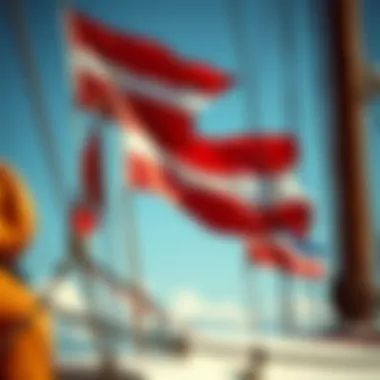
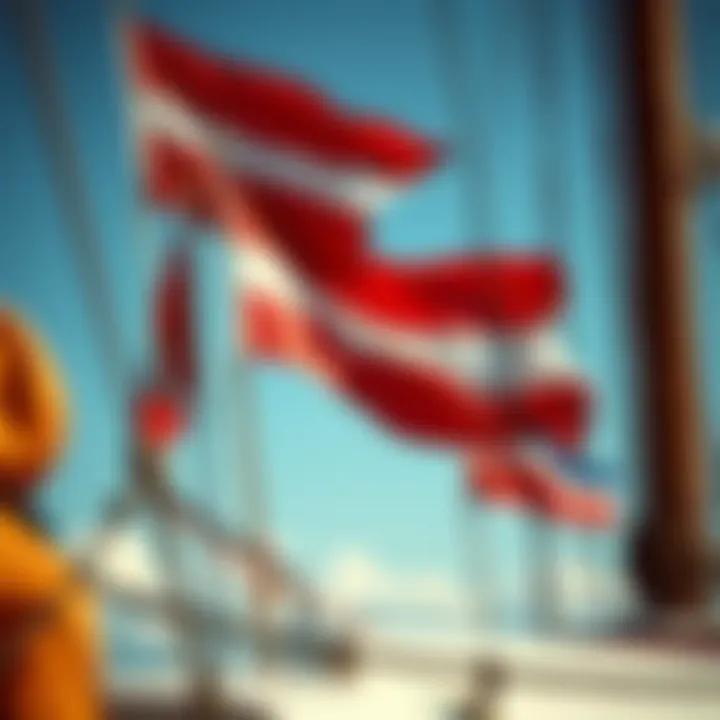
Numerical codes complement flag signals and are particularly useful for communicating more complex messages or instructions. These codes allow vessels to relay information about navigational details, weather updates, or safety warnings without needing lengthy explanations. The primary characteristic of numerical codes is their ability to condense information into a brief sequence of numbers that can be transmitted efficiently, which is advantageous for busy maritime environments.
A unique feature of numerical codes is that they can be easily integrated with other communication methods, such as radio transmissions, further enhancing their versatility. However, one drawback might be the requirement for crew members to memorize or familiarize themselves with a range of codes, which can sometimes detract from overall effectiveness.
Practical Applications for Sea Navigation
The practical applications of the International Code of Signals in sea navigation are vast and varied. From merchant shipping to recreational sailing, the National Code of Signals provides a framework for effective communication at sea. Mariners rely on the ICS to convey essential messages, ensuring safe operations while on the water, and fostering an environment of cooperation and safety across international waters.
Usage of Signal Flags in Modern Maritime Activities
Signal flags have held an essential position in maritime activities, even as technology evolves. Their role extends beyond mere decoration; they provide a language that can be universally understood, ensuring that vessels communicate effectively regardless of language barriers. Understanding how signal flags operate is crucial for any seafarer, whether a casual navigator or a professional sailor. Their importance in ensuring safe and efficient navigation cannot be overstated.
Emergency Signaling
In emergencies, clear and immediate communication can mean the difference between life and death. Signal flags are a critical tool in this context, offering a visual method for vessels to indicate their distress or specify the nature of an emergency. For instance, the 'N' flag signifies a distress call, and the 'C' flag indicates that a vessel requires assistance. By raising these flags, crew members can visually convey urgent messages to nearby ships, even when verbal communication is impossible due to distance or noise. This form of signaling is particularly vital in rough sea conditions where radio communication can fail.
Communicating with Other Vessels
Clear communication with other vessels on the water is pivotal for maintaining safety and order. Flag signaling allows for a visual and often quicker means of relaying needs, warnings, or information. When at sea, a ship can hoist specific flags to communicate intentions to approaching vessels without requiring them to come dangerously close.
Flag Hoisting Procedures
Flag hoisting is more than just a routine; it's a carefully choreographed procedure that ensures clarity in communications. Each flag has designated meanings, and when hoisted in specific sequences, they can relay complex messages quickly. For instance, a vessel wishing to indicate that it is anchoring can display the appropriate flags in a specific order known to experienced sailors.
One key characteristic of flag hoisting procedures is standardization: sailors learn to recognize flags and their meanings globally. This consistency is beneficial as it allows for clear communication among sailors who speak different languages. However, one downside is that improper hoisting or misinterpretation can lead to misunderstandings, with potentially serious consequences such as collisions or accidents at sea.
Common Flag Combinations
When it comes to conveying more complex messages, common flag combinations are indispensable. By raising certain flags together, vessels can send messages such as requesting a pilot onboard or notifying others of specific navigational instructions. This method allows ships to communicate detailed information in a relatively brief and efficient manner.
A noteworthy aspect of common flag combinations is their flexibility. For instance, combining the flags "B" (Bravo) and "R" (Romeo) can convey a vessel's readiness to receive. However, there is a caveat: because these flags can serve different meanings in various contexts, sailors must be well-versed in the standard code to avoid confusion. Understanding the context in which flag combinations are used is crucial for effective maritime operations.
Cultural and Historical Significance
The usage of signal flags is steeped in rich maritime history. They've evolved from simple forms of regional signaling systems into a global standard that bridges cultural gaps. Throughout centuries, different naval forces have contributed to the rich tapestry of maritime communication.
Signal flags today serve as not just operational tools but also as symbols of maritime tradition. They are often displayed by sailing schools and during maritime events, reminding everyone of the sea's vast stories and the importance of communication on the water.
"A well-placed signal flag can relay a message more effectively than hundreds of words on paper."
Signal Flags in the Surfing Community
Understanding the connection between international maritime signal flags and the surfing community is key to grasping how communication operates not just on the open seas but also at popular surf spots. Surf culture, much like maritime practices, relies heavily on visual cues for safety and coordination among surfers, lifeguards, and water enthusiasts. The ability to interpret these signals can mean the difference between a calm day on the water and a potential safety hazard. Here, we will explore the specific elements and protocols that have emerged within this eclectic community, reinforcing the relevance of signal flags in enhancing safety and enjoyment in surfing.
Adopted Practices Among Surfers
In many coastal areas, surfers and local communities have taken it upon themselves to adapt traditional maritime signal flags for their unique needs. Flag systems are often displayed prominently at beaches to convey important information. Common practices include:
- Condition Indicators: Flags signal wave height, strong currents, and tide changes, providing surfers with vital information for planning their sessions.
- Warning Signs: Certain flags denote hazardous conditions, like rip currents, shark sightings, or environmental issues. A simple color change can alert surfers to evacuate the water or exercise caution.
- Lifeguard Communication: Lifeguards might also use flags to communicate with surfers about safety protocols or to express situations requiring immediate attention.
Surf Safety Protocols
Flag Signals Used in Surfing
Integrating flag signals into surfing safety protocols serves as a pragmatic solution to the unique challenges faced by surfers. The prominence of flag signals in the water is a key characteristic because it allows for instant recognition and response. Some crucial aspects include:
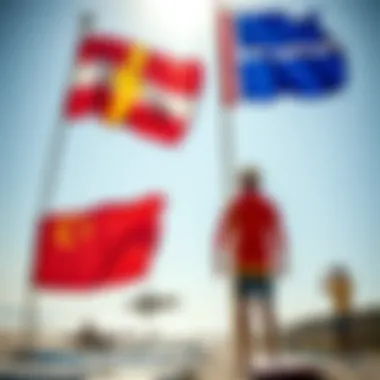
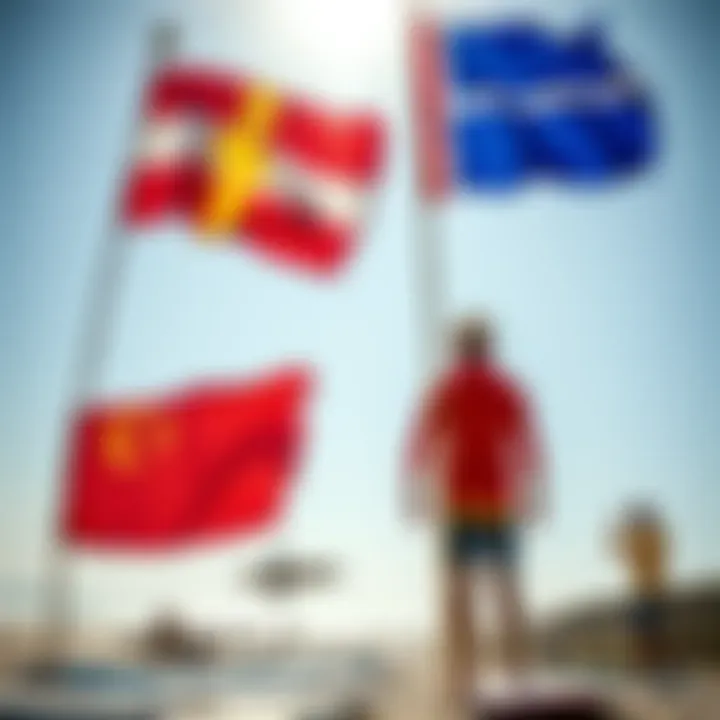
- Specific Color Codes: For example, red flags signal dangerous conditions, while green flags indicate that conditions are safe for surfing. This system is a beneficial choice especially in areas with heavy tourist activity, reducing confusion and enhancing response times.
- Visibility and Recognition: Being vivid and easy to spot against the ocean backdrop gives flag signals a unique advantage. They serve to inform surfers quickly without overwhelming them with information. This leads to effective safety measures during busy surfing hours.
However, the reliance on flag signals can also have its downsides, such as variations in color interpretation across different regions, which could potentially lead to misunderstandings.
Emergency Response Strategies
In times of emergency, having clear communication methods in place is crucial. The emergency response strategies employed in the surfing community often incorporate the use of flags along with standard safety protocols. Some key points encompass:
- Immediate Communication: Flags can provide immediate visual cues during emergencies such as sudden weather changes, allowing surfers to take quick action. The agile nature of flag signaling is a beneficial aspect, enhancing overall safety measures.
- Collaboration With Authorities: In emergency situations, local lifeguards and authorities utilize flags to coordinate rescue efforts efficiently, ensuring that surfers know the safest actions to take. This collaborative environment minimizes risks and creates a more secure surfing atmosphere.
On the other hand, the challenge lies in ensuring that all surfers are proficiently aware of and trained in these systems. A lack of knowledge or misunderstandings regarding flag meanings can endanger lives in grim situations, emphasizing the need for education and awareness.
By embracing the use of signal flags within surfing culture, the community enhances its safety protocols while establishing a stronger connection to maritime traditions. As the lines between ocean usage and safety blur, embracing these visual tools continues to hold significance for surfers, fostering a culture of safety, awareness, and respect for the sea.
Contemporary Adaptations of Signal Flags
Maritime signal flags have long served as an essential means of communication among sailors and vessels. However, as our world changes at breakneck speed, these flags have found their place evolving within contemporary contexts. This section delves into the innovative adaptations that are taking place within the realm of signal flags, focusing on how they are being integrated into modern communication tools and leveraging social media for enhanced engagement.
Innovative Communication Tools
The rise of technology has revolutionized several fields, maritime communication being one of them. Signal flags, once confined strictly to traditional applications, have now influenced a range of modern communication tools. For instance, smartphone applications have been developed to interpret signal flags, allowing users to decode messages instantly while at sea, enhancing safety and efficiency.
Often, these apps also feature educational tools, including interactive games and quizzes, that teach users about the meanings of various flags. This creates an engaging platform for both beginners and seasoned mariners to better understand maritime signaling.
- Educational Resources: These apps frequently offer tutorials on how to hoist the flags correctly, improving the chances of successful communication between vessels.
- Real-Time Updates: Many of these tools support real-time tracking functionalities, enabling sailors to connect instantly with other vessels and shore stations, ensuring that critical information is shared without delay.
By transforming traditional symbols into digital formats, innovators are enhancing the effectiveness of maritime communication among a new generation of seafarers.
Social Media Influence on Messaging
In today's interconnected world, social media plays a vital role in shaping how we communicate and share information. Maritime communities are no exception to this trend. Through platforms like Facebook, Instagram, and even Reddit, signal flags are becoming widely recognized and discussed. Understanding the significance of this change can provide insights into maritime culture aimed at younger generations who may not have the same direct exposure to traditional seaworthy practices.
Social media's influence can be seen in several ways:
- Awareness Campaigns: Organizations are utilizing the visibility of social media to run awareness campaigns about signaling safety and communication protocols. This draws attention to the relevance of the flags, not only to professional seafarers but also to casual mariners and surf enthusiasts.
- Visual Storytelling: Platforms that emphasize imagery allow the unique designs of signal flags to shine, grabbing interest and educating the audience about their meanings. A single post featuring the flags can spark curiosity, leading to further inquiry about maritime traditions and safety.
Incorporating signal flags into modern messaging techniques changes perceptions and utilizes platforms that engage a broader audience. By bridging the gap between traditional practices and contemporary interactions, the maritime community can foster an environment where both safety and cultural heritage are preserved.
Quote: "The evolution of communication tools through innovative adaptations allows maritime signals to remain relevant in our fast-paced, technology-driven society."
In summary, the contemporary adaptations of signal flags not only demonstrate their undying importance but also facilitate learning and communication in a rapidly changing world. The blend of traditional maritime practices with modern technology and social media opens up new pathways for knowledge and safety on the open waters.
Culmination: The Future of Maritime Communication
As we navigate through the sea of technological advancements and cultural shifts, the future of maritime communication stands at a fascinating crossroads. Today, traditional methods like international maritime signal flags are still pivotal in ensuring safety at sea, yet they face unique challenges from emerging technologies. The significance of maintaining these age-old practices cannot be overstated, as they not only provide a visual language understood across diverse cultures, but they also contribute to the spirit of maritime tradition.
Challenges and Opportunities
While innovation in communication technology—such as satellite communications, GPS, and digital messaging systems—provides numerous advantages in efficiency, there are also several challenges that come with it. For one, the reliance on high-tech communication tools can lead to a diminishing understanding of traditional methods like flag signaling.
- Loss of Skills: As sailors become more dependent on electronic systems, the vital skills associated with traditional signaling techniques may dwindle, potentially endangering crews if technology fails in critical moments.
- Training Demands: The industry may face a growing demand for dual training—ensuring that seafarers are well-versed in both advanced technologies and timeless techniques like flags.
- Cultural Persistence: Maintaining the cultural heritage of maritime signaling amongst newer generations can be a challenge, yet an opportunity exists to promote this through educational programs.
In contrast, there’s a significant opportunity to integrate traditional methods with modern practices. Imagine sailors using signal flags not only for emergencies but also as a means to connect with maritime heritage in a technological world, crafting a bridge between past and present. The innovative combination could enhance safety protocols while celebrating maritime culture.
Preserving Traditions in the Face of Technology
Although technology continuously evolves, the necessity of preserving traditional maritime communication, including signal flags, is paramount for future generations. This preservation goes beyond simply maintaining a historical practice; it plays a crucial role in fostering a sense of identity and unity among sailors and maritime communities.
- Cultural Festivals: Maritime communities can host events focusing on traditional signaling, actively encouraging younger generations to engage with history and learn the significance behind the flags.
- Education: Implementing maritime courses in educational institutions can help reinforce knowledge about both historical and contemporary communication methods, ensuring that the language of the sea is passed down.
- Innovative Uses: With a twist of creativity, signal flags could be reimagined in art and social media platforms to reach broader audiences, showcasing their aesthetic as well as functional value.
Adapting to modernization doesn't need to mean letting go of traditions. Sailors, enthusiasts, and educators alike can find innovative ways to honor the legacy of maritime signal flags while embracing what technology has to offer. In this way, we ensure the survival of both a vital communication tool and the rich tapestry of history from which it comes.



